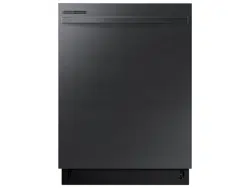Documents: Go to download!
- Owner's manual - (English, French, Spanish)
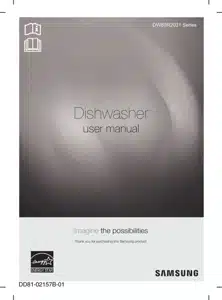
- CONTROL PANEL
- setting up your dishwasher
- cleaning and maintaining your dishwasher
- troubleshooting
- SPECIFICATIONS
Table of contents
USER MANUAL Dishwasher
CONTROL PANEL

| 1.Power | When you press the Power button, the entire display turns on and off, and then the light of the most recently finished cycle lights up. When the selected cycle is complete, the dishwasher powers off automatically |
| 2. Cycle Selector | Select the appropriate wash cycle depending on the soil level of your dishes. After you select a cycle, the Cycle On light for that cycle lights up. If a proble occurs during an operation, (Control Lock) / m specific LEDS blink, indicating the cause of the problem. The blinking is accompanied by a warning tone. For more information, refer to "Information Codes" on page 26. |
| 3. Hi-Temp Steam Wash | Raises the main wash temperature to improve cleaning for loads containing tough, baked-on food.
|
| 4. Sanitize | The temperature rises to 15 °F ( 70°C) in the final rinse cycle for high temperature sanitization. If you select the Sanitize option, the “Sanitize” lamp blinks when the water temperature reaches the sanitary temperature (over 156 °F (69 °C)), and then remains illuminated until the Sanitize option ends. When you press the Power button, the “Sanitize” lamp turns off.
|
5. Heated Dry/ (Control Lock) (Control Lock) | When the “Heated Dry” function is selected,the heater will work during the drying process. Control Lock allows you to lock the buttons on the control panel so children cannot accidently start the dishwasher by pressing the buttons on the panel. To lock and unlock the buttons on the control panel, hold the Heated Dry button down for three (3) seconds when power is On. |
| 6. Delay Start | Delay a cycle for 3,6 , or 9 hours , The hour displayed indicates the time at which the dishwasher will start. |
| 7. Clean | Indicates that the operation is over and that your dishes are clean. |
| 8. Start | To start a cycle, press the Start button before closing the door. To cancel the cycle, press and hold the Start button for 3 seconds or press the Power button to power off the dishwasher |
CYCLE SELECTOR
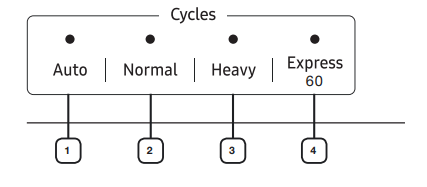
| 1.Auto | This cycle detects the level of soil and automatically initiates the optimal cycle after a few minutes of operation. |
| 2. Normal | Use this cycle for normally soiled dinner dishes. |
| 3. Heavy | Use this cycle for heavily soiled dishes and dishes with heavy soil. |
| 4. Express 60 | Use this cycle for lightly soiled dishes. |
setting up your dishwasher
BASIC GUIDELINES
1. Open the door and load your dishes
- Place dishes into the upper and lower racks, unless you have selected Lower Rack.
- Remove any food remains from the dishes before placing them in the rack(s).
- After placing the dishes into the racks, rotate the nozzles by hand to check whether any of the dishes will interfere with them.
- Make sure the dishes will not prevent the detergent dispenser from opening.
2. Add detergent to the dispenser
- Make sure to use only automatic dishwasher detergent and rinse aid.
- Refer to “Using detergent” on page rinse aid.
3. Press the Power button.
- When you press the Power button, the entire display turns on and off, and then the indicator of the most recently finished cycle lights up.
4. Select an appropriate cleaning cycle depending on the soil level of the dishes
- Press the appropriate cycle button.
- When you press a cycle button, the cycle indicator lights up.
5. Press the Start button, and then close the door within 3 seconds.
- The dishwasher will start draining after a few seconds, and then start the selected cycle.
- Make sure to close the door firmly. If the door is not closed properly, the selected cycle will not start automatically.
6. When the wash cycle is completed.
- The light illuminates and the dishwasher sounds a chime.
- The dishwasher powers off automatically
ADJUSTING THE HEIGHT OF THE UPPER RACK
You can adjust the height of the upper rack in your Samsung dishwasher so that the lower rack can accommodate larger sized dishes. With the upper rack set at the highest position, the lower rack can accommodate plates up to 12 in. (30 cm) in diameter and the upper rack can accommodated plates up to 8 in. (20 cm) in diameter.
| 1.To lower the upper rack by 2 in. (5 cm), remove the upper rack as shown in Removing the Upper Rack below. Then reinsert the rack so that the upper four wheels on each side of the rack are above and below the guide rail. See the ower position illustration to the right | 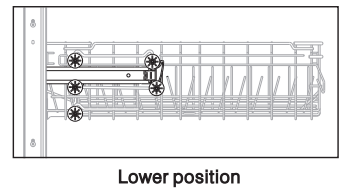 |
| 2. To raise the upper rack, remove the upper rack as shown in Removing the upper rack below. Then, reinsert the rack so that the lower three wheels on each side of the rack are above and below the guide rail. See the Upper position illustration to the right. | 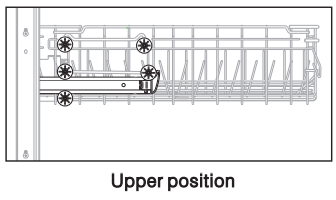 |
REMOVING THE UPPER RACK
Pull the upper rack towards the front and then remove it by lifting it up slightly and pulling it towards the front. See the illustrations below.

LOADING THE LOWER RACK
The lower rack has been especially designed for dinner dishes, soup bowls, plates, pots, lids, casserole dishes, and plates.
Load large items such as pans and pots into the dishwasher so their open sides face downwards. We recommend loading cups, stemware, and small plates into the upper rack.
See the recommended loading patterns below.
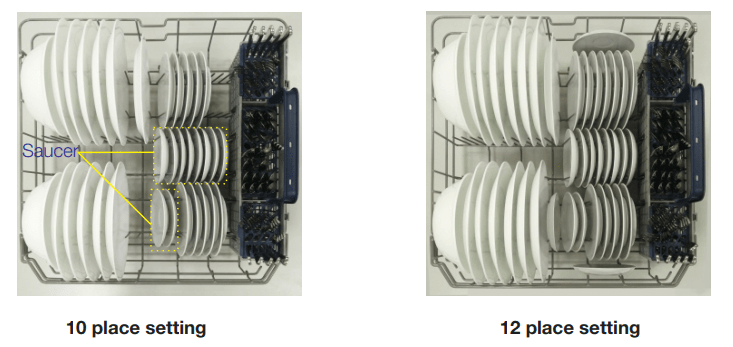
LOADING THE UPPER RACK
The upper rack has been designed for small plates, mugs, glasses, and plastic items marked “dishwasher safe”. Load your plates into the dishwasher in two half rows, so that the front of each plate faces the back of the plate in front of it, and the open sides of the plates at the center of the dishwasher face each other. See the illustrations below.
Make sure the loaded dishes do not interfere with the rotation of the nozzle which is located at the bottom of the upper rack. (Check this by rotating the nozzle by hand.)
When loading dishes, pull the upper rack out suficiently so you can load it without striking the counter above.
USING DETERGENT
All dishwasher cycles require detergent in the detergent compartment.
Add the correct amount of detergent for the selected cycle to ensure the best performance
Filling the detergent dispenser
1. Open the detergent dispenser cap by pushing the detergent dispenser release catch.
| 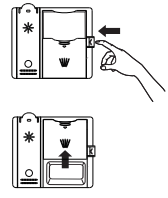 |
2. Add the recommended amount of detergent to the main wash detergent compartment. 3. Close the flap by sliding it to the and then pressing it down. | 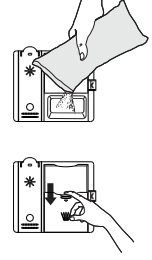 |
4. For better cleaning result, especially if you have very dirt items, pour a small amount (about 15 g) of detergent onto the door. The additional detergent will activate during the pre-wash phase. | 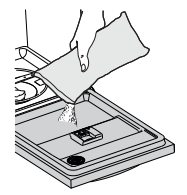 |
The cover opens automatically to dispense the detergent during the wash.

Filling the rinse aid reservoir
Your dishwasher has been designed to use liquid rinse aid only.
Using a powdered rinse aid will clog the reservoir opening and cause the dishwasher to malfunction
Rinse aid improves the drying performance of the dishwasher.
1. Open the rinse aid reservoir cap. | 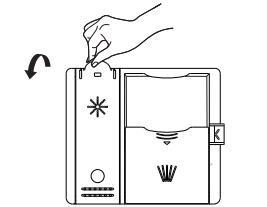 |
2. Fill the rinse aid reservoir with rinse aid.
| 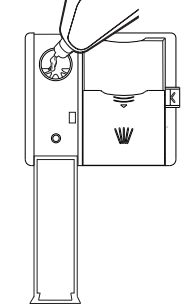 |
3. View the amount of rinse aid in the reservoir through the clear viewing port. Stop adding when the reservoir reaches the full level. 4. Close the rinse aid reservoir cap. | 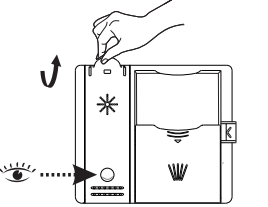 |
cleaning and maintaining your dishwasher
Keeping your dishwasher clean improves its performance, reduces unnecessary repairs, and lengthens its life.
CLEANING THE EXTERIOR
It’s best to clean spills on the outside of your dishwasher as they occur. Use a soft, damp cloth on the control panel to gently wipe away spills and dust. Do not use benzene, wax, thinner, chlorine bleach, or alcohol. These materials may discolor the inner walls and cause stains. Do not clean the dishwasher by sprinkling water over it and avoid letting water come into contact with any of the electrical parts.
CLEANING THE INTERIOR
Clean the interior of your dishwasher periodically to remove any dirt or food particles. Wipe the inside of the dishwasher and the inner part of the door with a wet dishcloth. We recommend filling the detergent dispenser with dish detergent, and then running the dishwasher empty periodically using either the Normal or Express 60 cycle with the sanitize option. This will keep your dishwasher clean.
If white spots and odor are still present in your dishwasher, run the Normal cycle with the dishwasher empty and without detergent until it flushes. Then, interrupt the cycle and put an 8 ounce cup of white vinegar into the lower basket. Close the dishwasher and let the cycle f finish.
CLEANING THE FILTERS
| 1. Turn off the dishwasher. | 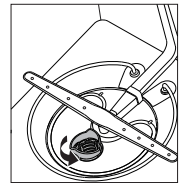 |
| 2. Rotate the filter insert counterclockwise to unfasten and then detach the filter insert. | 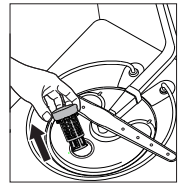 |
| 3. Remove the fine filter (flat, rectangular). |  |
| 4. Remove any dirt or other remains from the filter, and then rinse under running water. | 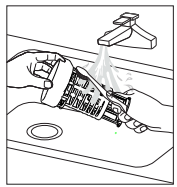 |
| 5. Reassemble the filter in the reverse order of the dissasembly, re-insert the filter insert, and then rotate clockwise as shown until close . |  |
CLEANING THE NOZZLES
If your dishwasher does not seem to be cleaning adequately or the nozzles seem clogged, you can clean each of the nozzles. When removing the nozzles, take care as they may break.
Lower nozzle
1. Check whether the nozzle holes are clogged by food particles. 2. If cleaning is needed, remove the nozzle by pulling it upwards. 3. Clean the nozzle, and then push it back into place. 4. Check whether the nozzle is engaged correctly by rotating it by hand. | 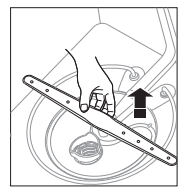 |
Middle nozzle
|  |
Upper nozzle
|  |
STORING YOUR DISHWASHER
If you need to store your dishwasher for an extended period of time, first drain and disconnect it. If you leave water in the hoses and internal components, you can damage the dishwasher.
After draining and disconnecting the dishwasher, be sure to turn off the water supply valve and circuit breaker.
troubleshooting
CHECK THESE POINTS IF YOUR DISHWASHER…
| PROBLEM | POSSIBLE CAUSE | SOLUTION |
| Will not start. | The door is not closed completely. | Check if the door is latched and closed completely. |
| No cycle is selected. | Select a proper cycle. | |
| The power cable is not connected. | Connect the power cable properly. | |
| The Control Panel is locked. | Unlock the child lock | |
| A circuit breaker is open. | Reset the circuit breaker. | |
| Is taking too long with an operation or cycle. | Cold water is being supplied. | Make sure the Water supply line is connected to a hot water supply (Additional time is required to heat cold water.) |
| Remains food particles on dishes. (Not cleaning properly.) | You selected an inappropriate cycle. | Select a cycle according to the number and soil level of the dishes, as directed in this manual. |
| The water temperature is low. | Connect the water supply line to a hot water supply. For best performance, the temperature of the supplied water should be 120 °F (49 °C ). | |
| Low water pressure. | The water pressure should be between 20 and 120 psi (140 - 830 kPa). | |
| The water is too hard. | Use high-quality, fresh detergent with rinse aid. | |
| Dishwasher detergent was not used. | Use automatic dishwasher detergent. We recommend a powder or gel type dishwasher detergent. | |
Detergent remains in the dispenser. 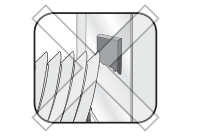 | Make sure large items such as cookie sheets, cutting boards, or contaners, etc. are not blocking the detergent dispenser and preventing it from opening properly. Rearrange the dishes so they do not interfere with detergent dispenser operation. | |
| There is no rinse aid. | Check the dispenser and add rinse aid. Use liquid type rinse aid. | |
| A nozzle is clogged. | Clean the nozzle ee page 20. | |
| The dishes are improperly loaded. Too many dishes have been loaded. | Rearrange the dishes so they do not interfere with nozzle rotation and detergent dispenser operation. Load only an appropriate number of dishes. Load your dishes as recommended. (See page 14.) | |
| Leaves glasses with a dull film. | The water supplied is soft and too much detergent was used. | Underload the dishwasher and use a rinse aid to minimize this. |
| Aluminum dishes were included in the wash load. | Remove the marks on the dishes using a low sensitivity cleaner. | |
| Leaves a yellow or brown film on the inside of the dishwasher. | This is caused by coffee and tea soils. | Remove the soils using a spot cleaner. |
| Does not dry dishes well. | There is no rinse aid in the dispenser. | Check the dispenser and add rinse aid. Use a liquid type rinse aid. |
| The temperature of the water is low when the dishwasher is running. | Make sure that the water supply line is connected to a hot water supply Use rinse aid with the Sanitize option. | |
| Too many dishes have been loaded. | Proper loading of items can affect drying. Load your dishes as recommended. (See page 14.) | |
| Glasses and cups with concave bottoms hold water. This water may spill onto other items when | After the cycle finishes, empty the lower rack first and then the upper rack. This will prevent water from dripping from the upper rack onto the dishes in the lower rack. | |
| Has a bad odor. | Water was left over from an incomplete cycle. | With the dishwasher empty, add detergent to the dispenser, and then run the Normal cycle dishwasher to clean the |
| The Drain Hose is obstructed. | Contact a qualified service technician to remove any obstruction from the drain hose. | |
| The dishwasher is not used daily or soiled dishes are left in unit too long. | With the dishwasher empty and no detergent in the dispenser, place a glass with 8 ounces of vinegar upright into the lower rack, and then run a Normal cycle. | |
| Is too noisy. | Sound is generated when the dispenser cover is open and the drain pump is operating in an early stage. | This is normal operation. |
| The dishwasher is not level. | Ensure the dishwasher is level. | |
| Foreign material (a screw, a plastic piece) is in the pump chamber. | Contact a qualified service technician to remove foreign material from the pump chamber. | |
| There is a ‘chopping’ sound because a nozzle is bumping against the dishes. | Rearrange the dishes. | |
| Nozzle does not rotate smoothly. | Nozzle holes are clogged with food particles. | Clean the nozzle hole . See page 20. |
| The nozzle is blocked by a dish or pot and cannot rotate. | After placing the dishes into the racks, rotate the nozzles by hand to check whether any of the dishes interfere with them. | |
| Water won’t pump out of the dishwasher. | The drain is clogged. | Contact a qualified service technician to remove any obstruction from the drain hose and check the drain pump operation. |
| Has a bent upper rack after loading dishes. | The dishes are not loaded properly. | Load your dishes as recommended. (See page 14.) |
INFORMATION CODES
The Control Panel displays information codes to help you understand what is occurring with your dishwasher.
If your dishwasher has a problem, the CODE SYMBOL lights blink as shown below.
| Code Symbol | Meaning | Possible |
 | No water | The water tap isn't opened. The pressure switch is broken. The wash pump isn'tsn't work . There is a problem with the main PBA |
 | High-water level | The high water switch was activated 5 times for 5 seconds The high water switch was on continuously for 120 seconds. There is a problem with the Main PBA. |
 | Not reaching required temperature | The heater was on continuously for 60 minutes, but the water did not heat up to the required temperature. The heater is broken. The emperature detected by the thermistor is wrong. There is a problem with the Main PBA. |
 | Water leakage | The leakage switch is broken. The leakage switch was activated for 2 seconds. There is a problem with the Main PBA. |
 | Thermistor open-circuit failure | The thermistor suffered an open-circuit failure. There is a problem with the Main PBA. |
 | Abnormal operation of touch key-press | A touch key was operated abnormally or operated abnormally. Example: A key was pressed for more than 30 seconds. There is a problem with the Sub PBA. |
 | Abnormal signal | A touch key was operated abnormally or operated abnormally. Example: A key was pressed for more than 30 seconds |
There is a problem with the Main PBA. There is a problem with the Sub PBA. |
SPECIFICATIONS
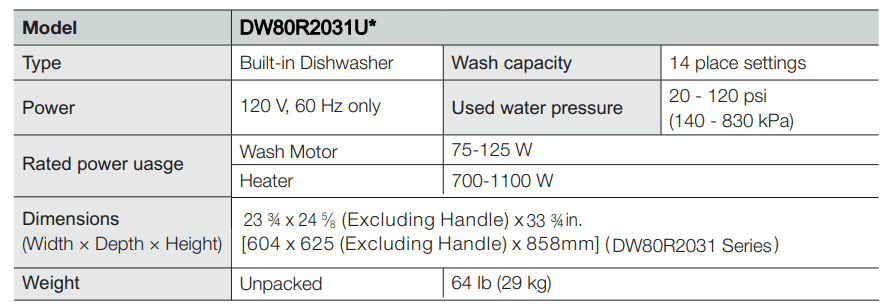
See other models: SM-T510NZDFXAR SMH7150BE/XAA SMH6140CB/XAA SM-R3600DANXAR AW25ECB7XAA
 Hi-Temp Steam Wash is not available for the Express 60 cycle.
Hi-Temp Steam Wash is not available for the Express 60 cycle.